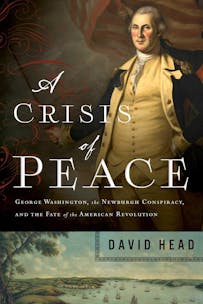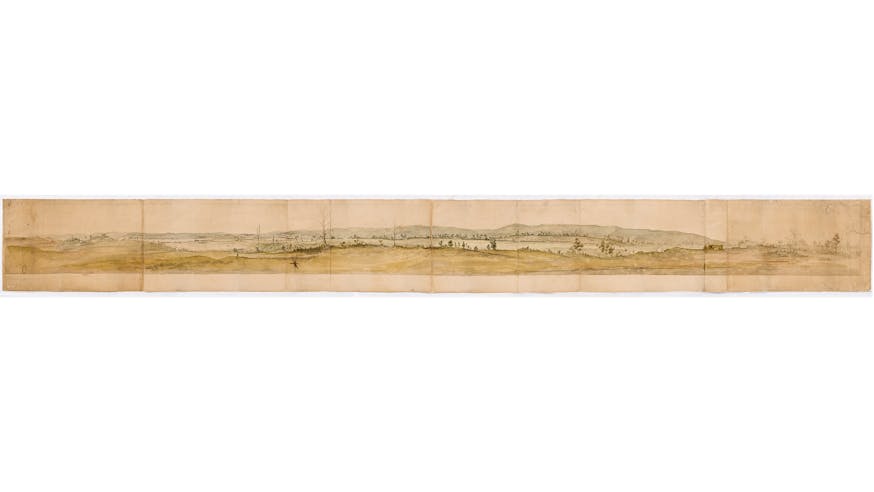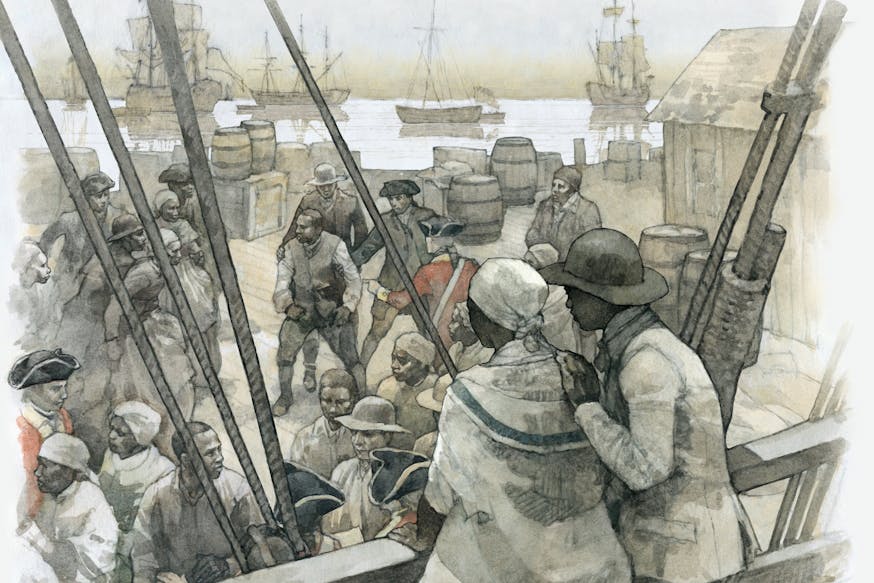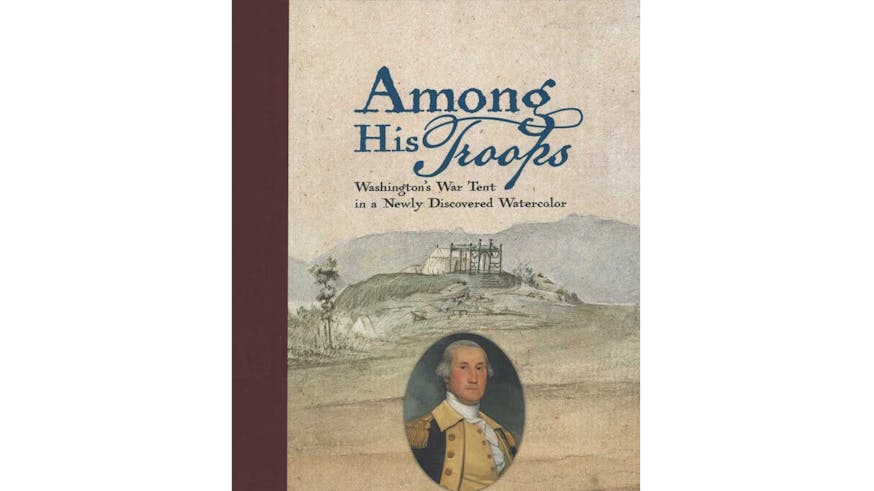Read the Revolution
A Crisis of Peace
July 14, 2021
Purchase the book from Simon & Schuster.
In A Crisis of Peace: George Washington, the Newburgh Conspiracy, and the Fate of Revolution, David Head takes readers to General George Washington’s camp at Newburgh, New York, where the war became critical after the British surrender at Yorktown. While peace was negotiated in Europe, the Newburgh Conspiracy of 1783, an alleged plan for military rebellion within the Continental Army, presented military, economic, and political dangers.
In the waning months of 1782, prior to the challenge he faced at Newburgh, Washington considered his options for going on the offensive against the British in New York City. He placed firm reliance on the allied French Army that was still stationed in the United States. Washington established a grand encampment of the Continental Army at Verplanck’s Point, New York, at the end of August 1782 to demonstrate the army’s fighting spirit and professionalism to their French allies. You can now explore an eyewitness image of the Verplanck’s Point encampment from the Museum’s collection through this newly launched online interactive feature, Picturing Washington’s Army.
Read an excerpt from Chapter 2: “An Insipid Campaign” about Washington’s planning in the summer and fall of 1782, including an interruption by a surprising birthday party at West Point, as the war continued and the Revolutionaries considered their next move.
Excerpt
Washington was as suspicious as any of his contemporaries, and though the British were quiet throughout the summer of 1782, he was sure it was a trick and a prelude to a new offensive. In early May a new British commander, Sir Guy Carleton, disembarked in New York City to take over the Crown’s operations in North America. The Irish-born Carleton was a veteran of colonial wars in Quebec and in Cuba and had previously served the king as military governor of Canada, where he deftly steered the colony away from aligning with the rebels to the south. The vicissitudes of army politics had sidelined Carleton for the previous few years, but back in the king’s good graces in 1782, he was called from his country estate to wind down the war in America.
Shortly after taking command, Carleton wrote Washington to inform him of the British disposition toward peace and offer his commitment to restraining violence against civilians. He urged Washington to do the same, presuming he was “alike interested to preserve the Name of Englishman from Reproach.” When Washington read the letter at the Hasbrouck House, he raised an eyebrow. British overtures, he thought, were a ruse to lull American defenses. News of the Royal Navy’s victory over France at the Battle of the Saints in the West Indies confirmed the general’s misgivings. Surely, the British would fight on in North America, too. For Washington, the best way to bring peace, as ever, was to prepare for war. “If they are only playing the insidious game,” Washington told Robert Livingston, “this will make them think of Peace in good earnest.”
Washington held out hope for a summer or early autumn attack on New York City, or, as a second choice, Charleston. An expedition into Canada was also on the table. But any operation depended on France. He needed the French army’s numbers and, if New York or Charleston were the objective, French naval support as well. In spite of their joint achievement at Yorktown, neither ally lived up to the expectations of the other. The Americans thought France should concentrate on fighting in North America, not the Caribbean. The French wondered why they did so much of the heavy lifting when so many American men refused to enlist to do their own fighting and the states failed to pay for their own defense.
Diplomatically sensitive, Washington cultivated a positive relationship with French officials through public displays of respect, even when the full symbolism didn’t quite make sense for the United States. In late May, Washington hosted a party at West Point to honor the birth of King Louis’s baby boy, Louis Joseph, the dauphin, the heir to the throne of France. Some 500 guests assembled under an enormous bower decorated with French and American flags for festivities that included dinner and the traditional thirteen toasts, each one announced with thirteen cannon blasts. Washington savored a toast raised to “a new edge to our swords, until they shall have opened the way to independence, freedom, and glory; and then may be converted to the instruments of peace.” No wonder they quaffed so many toasts: by the time such wordy salutes were finished, everyone was sobering up.
Afterwards, the American army executed a feu de joie, a rapid sequential firing of unloaded muskets. This display was extra elaborate, with troops stationed in a giant circle around the fort on both sides of the river. Thirteen more cannon blasts gave the signal to commence fire: flash, bang, flash, bang, flash, bang all around the line. Then they did it again, two more times. “The mountains resounded and echoed like tremendous peals of thunder,” Dr. James Thacher marveled, “and the flashing from thousands of fire arms in the darkness of evening, could be compared only to the most vivid flashes of lightning from the clouds.” The show concluded with the army shouting three cheers “of acclamation and benediction for the Dauphin”—a baby prince and next in line to the throne of a hereditary monarchy. The alliance was built on such compromises.
Sign Up!
Get biweekly Read the Revolution featured excerpts right to your inbox.
In early July, Washington got the news he’d been waiting for. The French fleet was sailing north to avoid hurricane season in the Caribbean, and General Rochambeau was moving the French army from Williamsburg, where they’d been encamped in idleness since Yorktown, to the headwaters of Chesapeake Bay. Finally, action! Washington galloped to Philadelphia to confer with Rochambeau about their target. There wasn’t a moment to lose.
Once together, Rochambeau proved less eager for battle than Washington. He declined the American’s three aggressive options in favor of a fourth. The French army would march to the Hudson and take up a position north of New York City and see what developed. At the very least, the French army would supplement American defenses and force Carleton to keep men in the city rather than releasing them for service in the Caribbean. Unable to persuade his ally to something more vigorous than rearranging the pieces on the geopolitical chessboard, Washington acquiesced. He attended another bash for the dauphin, hosted by the French minister, and returned to Newburgh at the end of July to await the French march north.
In the meantime, Carleton wrote again in August about “the pacific disposition of the Parliament and People of England toward the thirteen Provinces.” Negotiations were underway, Carleton reported, and the king consented to acknowledge independence. The British commander was ready to start exchanging prisoners; no need to make them suffer any longer. Washington doubted. “The enemy talk loudly, & very confidently of Peace,” he related to a French officer, “but whether they are in earnest, or whether it is to amuse and while away the time ’till they can prepare for a more vigorous prosecution of the War, time will evince.” In September, Carleton acknowledged to Washington that he considered the recovery of America a lost cause. He foresaw no further engagements. “I must,” he wrote, “frankly declare to you, that being no longer able to discover the object we contend for, I disapprove of all hostilities both by land and Sea.” Washington softened, but he still smelled a trap.
Wary of British designs, Washington prepared the army to move out at the end of August for Verplanck’s Point, about twenty-five miles south on the eastern shore of the Hudson, where they would rendezvous with the French. “What our object will then be,” one of Washington’s aides wrote, “must depend on the uncertainties of a month.” At 5:00 a.m. on August 31, the army was up and ready to board boats for the journey downriver and what the commander in chief promised would be “that happy moment” when the Continentals “shall again unite our standards with those of our generous and gallant Allies in the face of the common enemy.”
For the next two weeks, the chores of setting up a new place to live disrupted the summer’s ennui. Eager to impress his European counterparts, Washington assigned his men a course of drill, parade, and inspection, and he ordered the army to set up their tents with the “regularity” that is “extremely pleasing to the eye.” Washington wanted bowers erected outside the tents to provide shade—and to look nice—and he wanted more bowers to hide the vaults “as much as possible from view.” He would be watching. “By frequent passing along the line [the general] will have an opportunity of Judging which corps are most remarkable for their attention to regularity and even elegance.” Offering his approval to spur public competition among the soldiery—the sentiment was vintage Washington.
The army of King Louis arrived on September 14, and Washington led the troops out to honor General Rochambeau, who was suitably impressed. “You must have formed an alliance with the king of Prussia,” Rochambeau quipped. “These troops are Prussians.” Luckily, no republican zealots overheard the compliment. The French then bivouacked in Crompond, five miles to the northeast, and waited. More parades, reviews, and inspections followed, but it turned out the only common enemy the allies faced together was boredom. News filtered in that the British were abandoning Charleston; New York City was next, if the rumors were true. Washington’s hopes for conquest faded.
When October rolled around, the weather cooled and the army was back to its standard duty: sitting around doing nothing. Rochambeau had had enough. With further hostilities unlikely—and offering little reward with Britain poised to relinquish Charleston and New York—he decided to redeploy his force to the Caribbean. At the end of the month, the French broke camp and marched to Boston, where the navy would whisk them south for operations in warmer climes with their other ally, Spain. Before saying goodbye to Rochambeau, Washington completed one more grand review, dazzling the foreign officers and swelling his heart with pride. The campaign’s “last Grand Manoevre,” Washington said, saluting the troops, “surpassed every other exhibition of the kind that has been made in the American army.”
David Head, A Crisis of Peace: George Washington, the Newburgh Conspiracy, and the Fate of Revolution (Pegasus Books, 2019), 45-49.
Read the Revolution is sponsored by The Haverford Trust Company.
Read the Revolution is published biweekly by the Museum of the American Revolution to inspire learning about the history of the American Revolution and its ongoing relevance.
Tags

Explore rare paintings of the Continental Army at West Point and Verplanck's Point, including the only known wartime image of George Washington's tent, in the Museum's new Picturing Washington's Army interactive feature.
Explore OnlineLearn More

Panoramic View of Verplanck’s Point

Interactive Features

